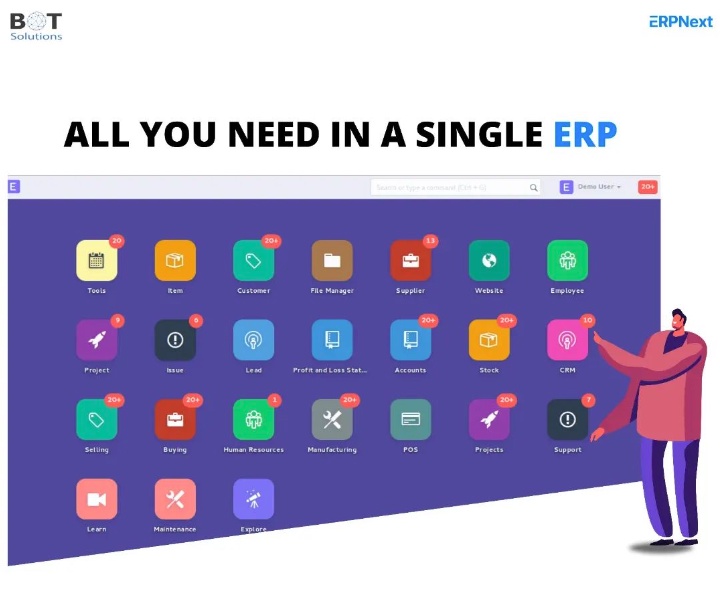In fast-paced world of modern business, staying ahead of the curve is essential for success. This is where ERP software comes into play, offering comprehensive solutions to streamline operations, enhance productivity, and drive growth. Among the plethora of options available, ERPNext stands out as a powerful and innovative software solution that is revolutionizing the way businesses manage their operations. In the guide, we will take a close look into the world of ERPNext software, exploring its features, benefits, implementation strategies, and real-world applications, empowering businesses to harness its full potential for success.
1. Understanding ERPNext:
At its core, ERPNext is an open-source, cloud-based ERP Software designed to streamline business progression and improve efficiency across all departments. Developed by Frappe Technologies Pvt. Ltd., ERPNext offers a suite of modules to manage various aspects of business operations, including accounting, inventory management, CRM, project management, human resources, and more. Its intuitive user interface, robust scalability, and features to make it a choice for businesses of all sizes, from startups to large enterprises.
2. Key Features and Modules:
ERPNext boasts an extensive array of features and modules that needs to the diverse needs of modern businesses. Its modular architecture allows users to customize & configure software according to their specific requirements. Some of the key modules include:
- Accounting: Manage financial transactions, track expenses, generate invoices, and reconcile accounts with ease.
- Inventory Management: Track inventory levels, manage stock movements, and streamline procurement processes.
- CRM: Manage customer relationships, track leads, and streamline sales processes to improve customer satisfaction and retention.
- Project Management: Plan, execute, and track projects from start to finish, ensuring timely delivery and optimal resource allocation.
- Human Resources: Streamline HR processes, manage employee records, track attendance, and automate payroll calculations.
3. Benefits of ERPNext:
The benefits of implementing ERPNext are numerous and far-reaching. Some of the key advantages include:
- Improved Efficiency: ERPNext automates routine tasks, eliminates manual data entry, and streamlines workflows, saving time and resources.
- Enhanced Productivity: By centralizing data and providing real-time insights, ERPNext empowers users to make informed decisions quickly, leading to increased productivity.
- Cost Savings: By optimizing processes and reducing inefficiencies, ERPNext helps businesses save money on labor, inventory, and other operational costs.
- Scalability: ERPNext is highly scalable, allowing businesses to easily add new users, modules, and functionalities as their needs evolve.
- Data Accuracy: With a single source of truth for all business data, ERPNext ensures data integrity and accuracy, reducing errors and minimizing risks.
- Improved Customer Satisfaction: By streamlining processes and providing better insights into customer needs, ERPNext helps businesses deliver exceptional customer service, leading to higher satisfaction and retention rates.
4. Implementation Strategies:
Successfully implementing ERPNext requires careful planning, collaboration, and execution. Here are some key strategies to consider:
- Needs Assessment: Identify your organization's specific requirements, goals, and challenges to ensure that ERPNext meets your business needs.
- Engage Stakeholders: Involve key stakeholders from across the organization in the implementation process to ensure buy-in and alignment with business objectives.
- Data Migration: Cleanse and migrate existing data into ERPNext to ensure data accuracy and integrity.
- Training and Support: Provide comprehensive training and support to users to ensure they are comfortable with the new system and can maximize its potential.
- Continuous Improvement: Monitor and evaluate the performance of ERPNext regularly, and make necessary adjustments to optimize its effectiveness.
5. Real-World Applications:
ERPNext has been adopted by businesses across various industries, including manufacturing, retail, healthcare, education, and services. Here are some real-world examples of how organizations are leveraging ERPNext to streamline their operations and drive growth:
- Manufacturing: A manufacturing company uses ERPNext to manage production schedules, track inventory levels, and streamline supply chain operations, resulting in improved efficiency & cost savings.
- Retail: A retail chain uses ERPNext to manage multiple store locations, track sales, and inventory, and analyze customer data to marketing campaigns & improve customer loyalty.
- Healthcare: A healthcare organization uses ERPNext to manage patient records, schedule appointments, and track medical supplies, ensuring efficient operations and high-quality patient care.
- Education: A university uses ERPNext to manage student admissions, course registrations, and faculty schedules, streamlining administrative processes and improving academic outcomes.
6. Community and Support:
As an open-source software, ERPNext boasts a vibrant community of developers, users, and contributors who actively collaborate to enhance the software and provide support to fellow users. Discover the wealth of resources available, including forums, documentation, tutorials, and community-driven initiatives, to facilitate your ERPNext journey.
7. Compilance & Software:
Compilance and Security are paramount considerations for any business software. Learn about the robust security measures and compliance standards upheld by ERPNext, ensuring confidentiality, integrity, and availability of your data while adhering to regulatory requirements.
8. Future Trends and Developments:
The landscape of business management software is constantly changing, driven by technological advancements and changing market dynamics. Explore emerging trends and developments in ERPNext, including the adoption of ai, machine learning, cloud computing, and blockchain technology, shaping the future of enterprise resource planning.
Conclusion:
In conclusion, ERPNext represents a paradigm shift in business management software, offering a comprehensive solution to streamline operations, enhance productivity, and drive growth. By understanding its features, benefits, implementation strategies, and real-world applications, businesses can unlock the full potential of ERPNext to thrive in today's competitive business environment.


No comments yet